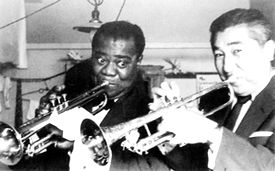JAZZ is an important cultural link across the Pacific between the United States and Japan: "A beautiful melody crosses national boundaries with ease!" This television program presents a vivid view of Japanese culture in the early 20th century, as reflected in the history of jazz in Japan. It traces the growing popularity of jazz from the first bands on trans-Pacific passenger vessels and in dance halls before 1920, to the popularity of the Florida Club and the emergence of the Japanese record industry in the 30's. The program also emphasizes the importance of Shanghai as a mecca for Japanese musicians and the popularity of American Nisei such as Betty Inada of Sacramento, who performed in Japan. Ultranationalist policy closed dancehalls in the late 1930's and early 40's, while propaganda broadcasts used jazz recordings on radio. Jazz boomed during the American occupation as many Japanese musicians took up jazz while small groups flourished in "live houses." Visiting Americans such as Gene Krupa, Louis Armstrong and Oscar Peterson enlivened the scene in the 1950's, and more recently Japanese jazz musicians have become stars in international jazz festivals.
Featuring Jazz Critic Masahisa Segawa, Jazz Singer Oida Toshio and the Koji Fujika Quintet.
Written by Host Sidney D. Brown.
Produced and Directed by Eugene Enrico
DVD, 28:30

